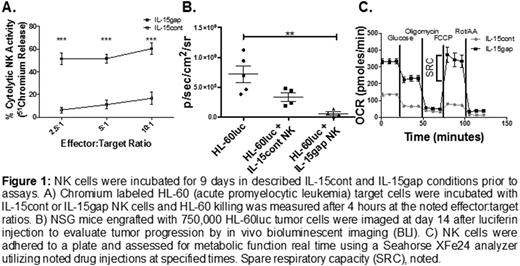Abstract
Natural Killer (NK) cells represent an exciting immunotherapeutic approach to treat cancer. We have shown that in vivo expansion and activation of donor NK cells supported by administration of IL-2 induces remission in patients with refractory AML. Recent clinical studies by our group have shown that IL-15 is superior to IL-2 to support NK cell persistence 14 days after adoptive transfer. However, only 36% of patients treated with 12 consecutive days of IL-15 had NK cell expansion to the level of ≥100 donor derived NK cells/µL blood compared to 10% in subjects treated with IL-2 (p=0.02). This leads us to conclude that we might not know the optimal route and interval to administer in vivo IL-15. We hypothesized that daily uninterrupted IL-15 dosing could lead to exhaustion or NK cellular stress. Therefore we designed an in vitro model system in which enriched NK cells are treated with three 3-day cycles of continuous IL-15 (IL-15cont) or were rested with a "gap" (skipping the middle cycle [IL-15gap]) before returning to the last cycle of IL-15. IL-15cont treatment yielded more proliferation and higher cell numbers compared to IL-15gap (4.8±0.44 vs. 1.9±0.26 million cells/ml, p < 0.0001) when cells were analyzed at the end of the three cycles (on day 9, where all in vitro measurements were taken). However, NK cell death, measured by flow cytometry, in the IL-15cont group was higher (18.9±2.2 vs 14.9±1.7 % cell death, p = 0.035) and this group also had an enrichment in genes involved in cell cycle checkpoint/ arrest, perhaps indicating more cellular stress in the IL-15cont. In an in vitro flow cytometric functional assay, the IL-15cont group had decreased activation when compared to the IL-15 gap group against K562 targets (43.6±2.1 vs 55.6±2.7 % CD107a [degranulation], p < 0.0001; 1.9±0.41 vs 7.1±0.93 % IFNg [inflammatory cytokine production], p = 0.0055). The decrease in NK cell activation correlated with a strong decrease in tumor target killing in an in vitro chromium release assay (Figure 1A) measuring killing of acute promyelocytic leukemia (HL-60) cell targets, in which the IL-15cont NK cells were potently outperformed by the IL-15gap cells (6.4±2.6 vs 51.5±4.8 % killing at 2.5:1 effector:target ratio, p < 0.0001). We used an in vivo xenogeneic model of AML, where conditioned NSG (NOD scid gamma) mice are engrafted with HL-60luc tumor targets 3 days prior to infusion with nothing, IL-15cont or IL-15gap human NK cells prepared within our 9 day culture system. Only the IL-15gap NK group mediated statistically significant tumor control when compared to tumor alone at two weeks following NK cell infusion (Figure 1B). To probe deeper into the functional defect we evaluated signaling after these treatments and noted decreased phosphorylation of several proteins in the IL-15cont group. These data led us to explore proteins involved in metabolism and we noted that CPT1A, a critical enzyme involved in fatty acid oxidation (FAO), was strongly increased in the IL-15gap treated NK cells (protein MFI of 15,759±2,603 [IL-15gap] vs 5,273±744 [IL-15cont], p = 0.009). Metabolic analysis using a Seahorse XFe24 analyzer showed an increased mitochondrial spare respiratory capacity (SRC) in the IL-15gap group, denoting better capability of the IL-15gap NK cells to respond to energetic demands (Figure 1C). In a separate experiment the groups were treated with etomoxir to inhibit CPT1A, and the SRC phenotype was reversed, with the IL-15gap group containing lower SRC than the IL-15cont group. To test these findings in a functional assay we repeated the IL-15cont treatment in combination with rapamycin, which can induce CPT1A through inhibition of mTORC1, and saw restoration of function to levels similar to IL-15gap (40.8±2.0 vs 49.3±2.9 % CD107a in the IL-15cont vs IL-15cont + rapamycin, p = 0.005; 2.4±0.47 vs 4.8±1.0 % IFNg in the IL-15cont vs IL-15cont + rapamycin, p = 0.03). These data indicate that NK cell functional exhaustion via continuous IL-15 signaling is mediated by a decrease in FAO. Intermittent IL-15 dosing or altering metabolism through other mechanisms may overcome this competition. These findings could impact ongoing clinical trials through simple alterations in dosing strategies in order to minimize NK cell exhaustion in the immunotherapeutic setting.
Cooley:Fate Therapeutics: Research Funding. Miller:Oxis Biotech: Consultancy, Other: SAB; Fate Therapeutics: Consultancy, Research Funding.
Author notes
Asterisk with author names denotes non-ASH members.


This feature is available to Subscribers Only
Sign In or Create an Account Close Modal